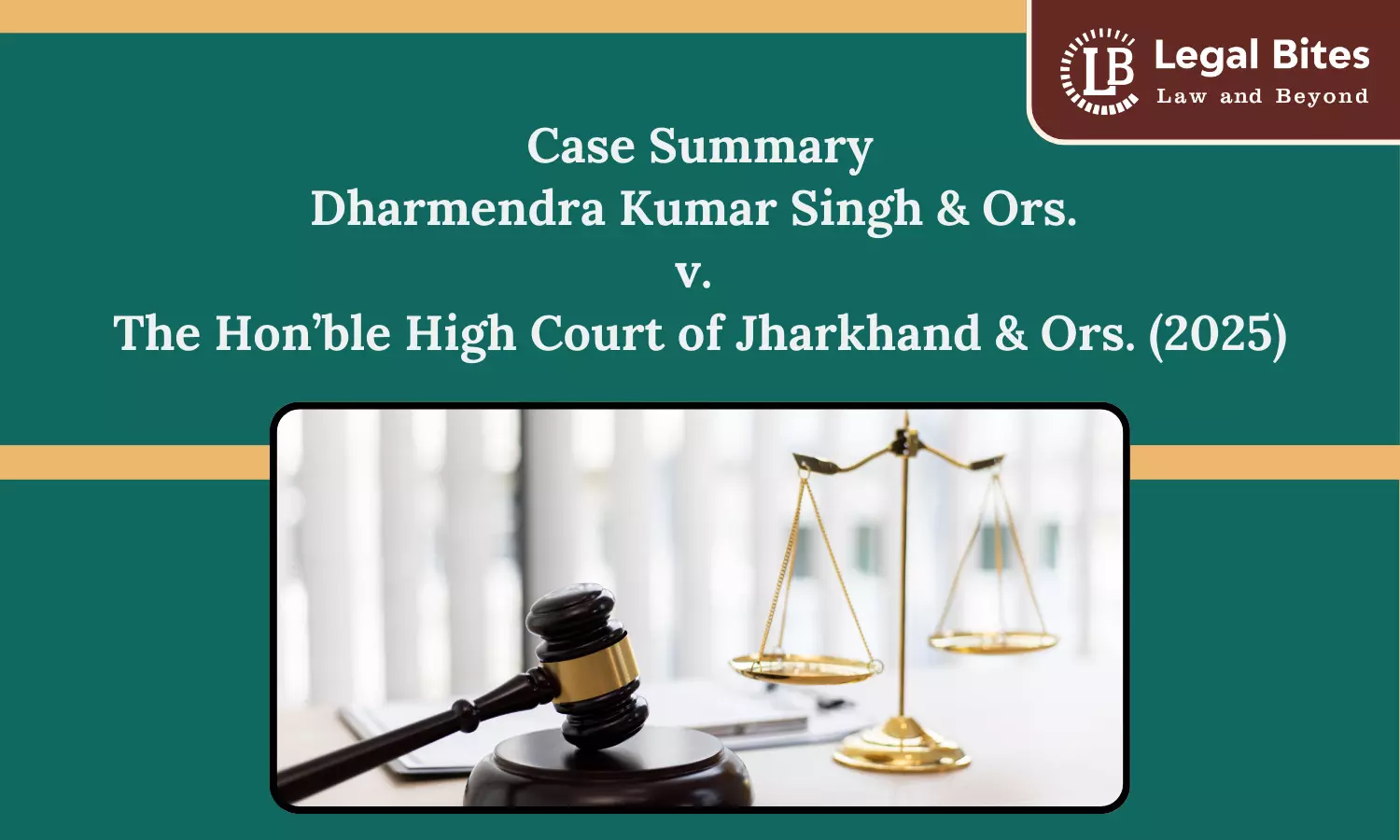Case Summary: Dharmendra Kumar Singh & Ors. v. The Hon’ble High Court of Jharkhand & Ors. (2025) | Merit-Cum-Seniority in Judicial Service
The Supreme Court addressed judicial promotions under the 65% merit-cum-seniority quota in Jharkhand Superior Judicial Service.

The Court, relying on its precedents, clarified that promotions under the 65% quota should not be treated as competitive and emphasized the balance between merit and seniority, ensuring the fair application of promotion rules.
Case Title: Dharmendra Kumar Singh & Ors. v. The Hon’ble High Court of Jharkhand & Ors.
Citation: Civil Appeal No. 299 of 2025
Court: Supreme Court of India
Bench: Justices Satish Chandra Sharma and B.V. Nagarathna
Date of Judgment: January 15, 2025
Background of the Case
The appellants, Dharmendra Kumar Singh and two others challenged a notification dated May 30, 2019, issued by the High Court of Jharkhand, which promoted certain judicial officers to the position of District Judge in the Jharkhand Superior Judicial Service. Their writ petition in the High Court was dismissed, prompting them to approach the Supreme Court.
The appellants, initially appointed as Civil Judges (Junior Division) and later promoted to the cadre of Civil Judges (Senior Division), argued that despite securing the minimum required marks in the suitability test, they were denied promotion because the High Court adopted a merit-based approach for promotion under the 65% quota.
Rules Governing Promotions
The case centred on the interpretation of the Jharkhand Superior Judicial Services (Recruitment, Appointment, and Condition of Service) Rules, 2001, particularly Rules 4 and 5, which outline the process and criteria for promotion to the post of District Judge:
Rule 4:
Appointments to the service are made via three modes:
(a) Direct Recruitment from the Bar (25%).
(b) Promotion on merit-cum-seniority (65%).
(c) Limited Competitive Examination (10%).
Rule 5:
For the 65% quota, promotions are based on merit-cum-seniority and require passing a suitability test with a minimum score of 40 marks.
The suitability test consists of the following components:
Interview: 20 marks
Service profile: 60 marks (based on ACR ratings over the past 10 years)
Judgment evaluation: 10 marks
Seniority: 10 marks (1 mark for each year of service as Civil Judge, Senior Division)
Arguments Presented
Appellants' Contentions:
- The appellants contended that the High Court's approach of preparing a merit list and promoting only those with higher marks contradicted the principles of merit-cum-seniority.
- They argued that once a candidate met the minimum suitability criteria (40 marks), their promotion should be based on seniority, not comparative merit.
- Reliance was placed on the Supreme Court’s earlier judgment in Ravikumar Dhansukhlal Mehta v. High Court of Gujarat & Ors. (2024 SCC Online SC 972), which clarified that promotions under the 65% quota should not be treated as competitive and suitability alone should be the determining factor.
Respondents' Contentions:
- The High Court of Jharkhand defended its decision, stating that it followed a merit-based approach to ensure promotions were awarded to the most deserving candidates.
- The respondents emphasized the importance of maintaining judicial efficiency and argued that the merit list was consistent with the principles of the 2001 Rules.
Interpretation of the 65% Quota
The Court closely examined the rules governing promotions and reiterated the principles laid down in All India Judges' Association (3) and the recent Ravikumar Dhansukhlal Mehta case:
Merit-cum-Seniority
- Promotions under the 65% quota are not intended to be competitive.
- Once a candidate achieves the requisite minimum marks in the suitability test, their promotion should primarily depend on seniority.
- Comparative merit, while relevant for other quotas like the 10% Limited Competitive Examination, is not the deciding factor under the 65% quota.
Suitability Test
- The purpose of the suitability test is to assess the continued efficiency and legal knowledge of judicial officers.
- Preparing a merit list and excluding candidates solely based on lower marks in the suitability test violates the principle of merit-cum-seniority.
Application of Precedents
- The Court heavily relied on its earlier decision in Ravikumar Dhansukhlal Mehta, which outlined the distinction between the 65% promotional quota and the 10% Limited Competitive Examination quota:
- The 65% quota is intended to balance merit and seniority, ensuring that senior officers meeting the suitability criteria are not overlooked.
- Treating the 65% quota as competitive would blur the distinction between the two categories of promotion.
Findings of the Court
Violation of Principles:
The Supreme Court found that the High Court of Jharkhand erred in applying a merit-based approach to the 65% quota. The appellants, having secured the minimum required marks (40), should have been promoted based on their seniority.
Subsequent Promotion and Seniority Issue:
The Court noted that the appellants were subsequently promoted, but their seniority had been adversely affected due to the delay. It ruled that the appellants were entitled to notional promotion from the date other officers were promoted under the May 30, 2019, notification.
Conclusion and Relief Granted
The Supreme Court allowed the appeal and set aside the High Court's decision. It directed that:
- The appellants be granted notional promotion from the same date as the other officers promoted under the May 30, 2019, notification.
- The appellants are entitled to all consequential service benefits, including seniority, increments, and notional pay fixation.
- However, they were not entitled to back wages.
Key Takeaways
- Principle of Merit-cum-Seniority: The judgment reinforces that promotions under the 65% quota should not be treated as competitive. Suitability and seniority are the primary criteria.
- Judicial Efficiency v. Seniority: While merit plays a role, the 65% quota is designed to recognize seniority, provided the officer meets the suitability threshold.
- Significance of Precedents: The decision underscores the importance of consistency in the interpretation of rules governing judicial promotions, drawing on precedents like Ravikumar Dhansukhlal Mehta.
- Balancing Fairness and Efficiency: The Court's ruling seeks to strike a balance between rewarding merit and respecting seniority, ensuring fairness in the promotion process for judicial officers.
Implications of the Judgment
This judgment has significant implications for the judicial promotion process in India:
- It provides clarity on the interpretation of merit-cum-seniority for judicial promotions.
- High Courts must ensure that promotions under the 65% quota adhere to the principles laid down by the Supreme Court.
- Judicial officers can challenge promotions if seniority is ignored despite meeting suitability criteria.
The Supreme Court’s ruling, in this case, strengthens the principles governing judicial promotions, emphasizing the need to respect seniority while ensuring the suitability, thereby maintaining fairness and consistency in the judicial system.
Click Here to Read the Official Judgment

